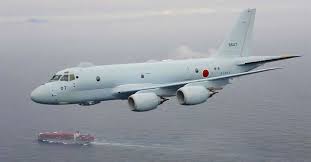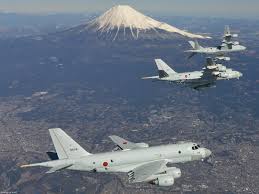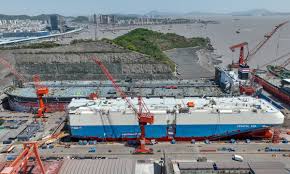Italy could choose Japanese Kawasaki P-1 maritime patrol aircraft to fill critical anti-submarine warfare gap.

Rome: According to both Marco Florian Geo and Pietro Batacchi, Director of Rivista Italiana Difesa, the Italian Air Force (Aeronautica Militare), in coordination with the Italian Navy (Marina Militare), seems to have chosen the Japanese Kawasaki P-1 as its preferred option for a new maritime patrol aircraft (MPA), a purpose-built platform designed for long-range and persistent surveillance missions.
The combat management system of the P-1, known as the Advanced Combat Direction System (HYQ-3), uses artificial intelligence to assist the Tactical Coordinator (TACCO) in optimizing flight profiles and engagement sequences. (Picture source: Japan Maritime Self-Defense Force)

This decision reflects an effort to restore a dedicated ASW capability following the retirement of the Breguet BR 1150 Atlantic aircraft in 2017 and the interim use of the Leonardo P-72A, which lacks anti-submarine warfare (ASW) armament. The aircraft would be customized with Italian components, likely including Leonardo’s ATOS mission system, MU90 heavy torpedoes, and the Marte ER B2+ missile, offering both ASW and anti-surface warfare (ASuW) capabilities.
Italy’s Multi-Year Programming Document for Defense (2022 to 2024) acknowledges the need for “aircraft equipped with special sensors for the purpose of providing the military instrument with a multi-purpose platform for long-range maritime surveillance under and above the surface,” but no acquisition has yet been funded or specified. Given that delivery of even off-the-shelf solutions, such as Germany’s P-8 order, can take up to three years from contract signature, delays in decision-making could exacerbate Italy’s capability gap. The risk is not only operational. As Admiral Credendino warned, continued lack of ASW platforms may erode institutional knowledge in anti-submarine operations across the Air Force and Navy. Time is a critical factor, and any further delays in acquisition planning may prolong a gap that has already lasted more than six years.
Italy’s current MPA fleet consists of four Leonardo P-72As, introduced between 2016 and 2017, as an interim replacement for the Breguet BR 1150 Atlantics, which were retired in 2017. While the Leonardo P-72A has been described as satisfactory for its intended surveillance role, it lacks the armament and operational reach needed for anti-submarine warfare (ASW). Although Leonardo has developed an ASW variant for export customers, the P-72 airframe may be deemed inadequate by decision makers to fulfill the operational requirements demanded for expanded patrol roles in the Atlantic and Mediterranean Sea. As noted by Admiral Enrico Credendino, Chief of Staff of the Navy, this absence has forced Italy to rely on allied support, particularly U.S. Navy P-8s stationed in Sigonella, Sicily. Credendino emphasized that whatever platform Italy acquires, domestic or foreign, it would take four to five years to reach operational readiness.
Brigadier General Francesco Agresti, an Air Force officer serving with the Navy’s Office of the Marine Aviation Inspectorate (ISPAVIAMAR), also underscored this urgency in January 2024, stating that Italy aims to re-establish a long-range ASW capability by 2029. The Italian defense establishment is concerned by the increased presence of non-NATO submarines in the Mediterranean and the ambitions of global actors such as Russia and China. These dynamics have prompted a reassessment of Italy’s maritime surveillance posture, especially considering the geopolitical sensitivity of key choke points, undersea infrastructure, and the strategic value of the Eastern and Southern Mediterranean. The Italian Navy also views this program as urgent, with its patrol tasks extending from the Eastern Mediterranean to the Balearic Islands and possibly beyond.
The future Italian maritime patrol aircraft (MPA) must meet demanding specifications: high survivability in non-permissive environments, multispectral ISR, long-range net-enabled communications, a high endurance profile, and rapid deployability. Italy evaluated several candidates, including Boeing’s P-8A Poseidon, Leonardo’s C27J in an ASW configuration, and the Kawasaki P-1. The P-8, already adopted by several NATO countries including Germany and the UK, offers broad capabilities, including SIGINT and SAR roles. However, it is an expensive platform and may partially duplicate other systems already in Italian service, such as the G550 CAEW. Moreover, the P-8’s configuration, derived from the Boeing 737, differs significantly from the turboprop aircraft historically operated by the Italian Air Force, complicating logistics and maintenance.
Kawasaki Heavy Industries was selected as the prime contractor in 2001, with the design aiming to avoid reliance on civilian airframes by creating a purpose-built platform for maritime patrol missions. (Picture source: Japan Maritime Self-Defense Force)
In contrast, the Kawasaki P-1 is a clean-sheet design optimized for maritime operations. Equipped with an internal bomb bay, larger than those found on the P-3C or P-8, is supplemented by eight external hardpoints. Its armament includes torpedoes such as the Mk 46, Type 97 (G-RX4), and Type 12 (G-RX5), as well as naval mines, depth charges, and air-to-surface missiles like the AGM-84 Harpoon, ASM-1C, and AGM-65 Maverick. The bomb bay, comparable in size to that of the Nimrod, can accommodate over 9,000 kilograms of munitions. For submarine detection and tracking, the P-1 carries up to 100 sonobuoys, with 30 pre-loaded in launch tubes and 70 stored onboard.
The Kawasaki P-1 originated from Japan’s ambition to develop an indigenous replacement for its aging P-3C Orion fleet, which had been produced under license by Kawasaki. Initial studies for a new maritime patrol aircraft began as early as the 1970s, but the modern program took shape in the early 2000s when Japan’s Ministry of Defense included the development of the P-X, later designated P-1, in its Five-Year Defense Plan. Kawasaki Heavy Industries was selected as the prime contractor in 2001, with the design aiming to avoid reliance on civilian airframes by creating a purpose-built platform for maritime patrol missions. The P-1 was developed alongside the C-X (now C-2) transport aircraft, sharing several structural and systems components to reduce costs. The aircraft made its first flight in September 2007 and officially entered service with the Japan Maritime Self-Defense Force in March 2013.
As of 2024, 34 aircraft have been delivered out of 48 ordered, with eventual plans to procure around 70. Despite previous interest from countries like the UK, New Zealand, and Germany, export sales have so far not materialized. Germany reportedly abandoned its consideration of the P-1 due to concerns about certification timelines. However, Italy’s growing strategic ties with Japan, underscored by a recent bilateral defense partnership, could favor a procurement agreement, potentially accompanied by localized maintenance infrastructure to offset the long Japanese supply chain.
The P-1 also features a fly-by-optics control system, an industry first, which reduces electromagnetic interference. Its main radar is the Toshiba HPS-106 X-band AESA system, which features four antennas for continuous 360-degree coverage and supports various modes, including SAR and ISAR imaging. A retractable Fujitsu HAQ-2 electro-optical turret under the nose combines FLIR and visible/infrared imaging sensors for day/night operations. The aircraft also carries a CAE-developed magnetic anomaly detector (MAD), integrated by Mitsubishi Electric, capable of detecting submarine signatures at low altitudes. Additional systems include the HLR-109B electronic support measures, the HLQ-9 self-protection suite with radar and missile warning sensors, and a Link 16-compatible data link terminal. The combat management system, known as the Advanced Combat Direction System (HYQ-3), uses artificial intelligence to assist the Tactical Coordinator (TACCO) in optimizing flight profiles and engagement sequences.
The Kawasaki P-1 possesses a maximum takeoff weight of 79,700 kilograms and measures 38 meters in length, with a wingspan of 35.4 meters and a height of 12.1 meters. Powered by four newly developed high-bypass IHI F7-10 turbofan engines, each delivering 60 kilonewtons of thrust, the P-1 reaches a maximum speed of 996 kilometers per hour and cruises at 833 kilometers per hour while offering quiet, fuel-efficient, and low-altitude flight suited for submarine detection. Its operational range extends to 8,000 kilometers, with a combat radius of approximately 2,500 kilometers. The aircraft operates at altitudes up to 13,520 meters and can carry more than 9,000 kilograms of munitions internally and externally, including torpedoes, depth charges, naval mines, and various anti-ship missiles. It is crewed by 13 personnel: two pilots and eleven mission operators.





